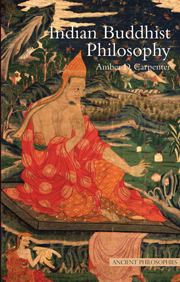Book contents
- Frontmatter
- Contents
- Preface
- Acknowledgements
- Abbreviations
- Chronology
- Development of Buddhist thought in India
- 1 The Buddha's suffering
- 2 Practice and theory of no-self
- 3 Kleśas and compassion
- 4 The second Buddha's greater vehicle
- 5 Karmic questions
- 6 Irresponsible selves, responsible non-selves
- 7 The third turning: Yogācāra
- 8 The long sixth to seventh century: epistemology as ethics
- Epilogue
- Background information
- Appendix 1 The languages of Buddhism
- Appendix 2 Intellectual context
- Appendix 3 The Abhidharma
- Appendix 4 Snapshot of Indian philosophy
- Notes
- Bibliography
- Index
Appendix 1 - The languages of Buddhism
from Background information
- Frontmatter
- Contents
- Preface
- Acknowledgements
- Abbreviations
- Chronology
- Development of Buddhist thought in India
- 1 The Buddha's suffering
- 2 Practice and theory of no-self
- 3 Kleśas and compassion
- 4 The second Buddha's greater vehicle
- 5 Karmic questions
- 6 Irresponsible selves, responsible non-selves
- 7 The third turning: Yogācāra
- 8 The long sixth to seventh century: epistemology as ethics
- Epilogue
- Background information
- Appendix 1 The languages of Buddhism
- Appendix 2 Intellectual context
- Appendix 3 The Abhidharma
- Appendix 4 Snapshot of Indian philosophy
- Notes
- Bibliography
- Index
Summary
Siddhartha Gautama was probably teaching in the fifth to fourth centuries BCE, although this date is disputed. He lived and taught in northern India, in the area that is now the state of Bihar, and in Nepal. The scholarly language of the sub-Continent at that time, and in the millennia following, was Classical Sanskrit – a later form of the language of the Vedas. Gautama spoke and taught in his local dialect/s, one [set] of the many vernaculars of Sanskrit [called prākrits], and not in Sanskrit.
This tradition of communicating in the local language, rather than the scholarly language, continued – and may have been a deliberate statement against reverence accorded any specific language, of the kind the Brahmans accorded Sanskrit. Thus, the oldest record of the Buddha's teaching which has come down to us was written in Pāli, another prākrit, possibly closely related to the Buddha's own vernacular.
As Buddhism spread, texts were translated into and composed in any number of local languages, including Chinese and Tibetan. As Buddhists in India became more philosophically engaged – with each other across different language-areas, and with non-Buddhists within the Brahamanical tradition – they began composing their works in Classical Sanskrit. The earliest texts this book treats were originally written in Pāli; the rest in Classical Sanskrit.
Because Pāli and Sanskrit are closely related, many words are similar, and variations between them easily recognized.
- Type
- Chapter
- Information
- Indian Buddhist Philosophy , pp. 242 - 243Publisher: Acumen PublishingPrint publication year: 2013



